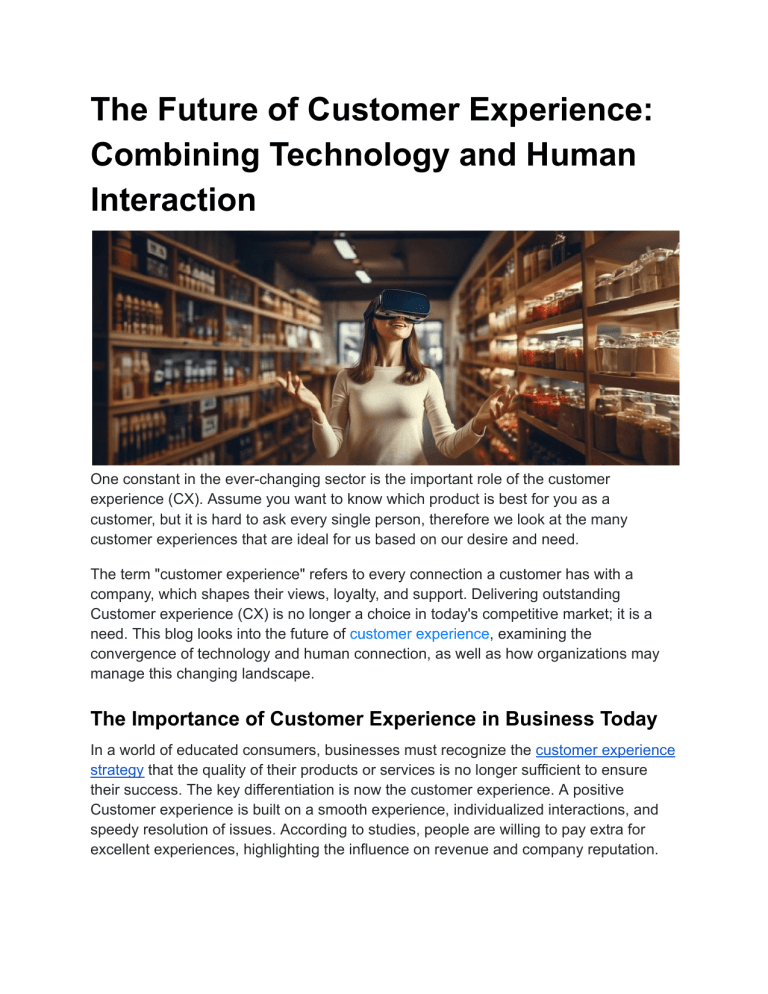The Future of Customer Experience Combining Technology and Human Interaction
advertisement

The Future of Customer Experience: Combining Technology and Human Interaction One constant in the ever-changing sector is the important role of the customer experience (CX). Assume you want to know which product is best for you as a customer, but it is hard to ask every single person, therefore we look at the many customer experiences that are ideal for us based on our desire and need. The term "customer experience" refers to every connection a customer has with a company, which shapes their views, loyalty, and support. Delivering outstanding Customer experience (CX) is no longer a choice in today's competitive market; it is a need. This blog looks into the future of customer experience, examining the convergence of technology and human connection, as well as how organizations may manage this changing landscape. The Importance of Customer Experience in Business Today In a world of educated consumers, businesses must recognize the customer experience strategy that the quality of their products or services is no longer sufficient to ensure their success. The key differentiation is now the customer experience. A positive Customer experience is built on a smooth experience, individualized interactions, and speedy resolution of issues. According to studies, people are willing to pay extra for excellent experiences, highlighting the influence on revenue and company reputation. Evolution of Customer Experience In the past, direct contact and reputation were the primary sources of consumer experience. As trade grew performance metrics, call centers became the primary point of contact. These channels, however, were frequently limited by operational hours and capacity. With the introduction of the internet, online help and self-service alternatives grew more common, enhancing connectivity but often at the cost of the personal touch. Emerging Technologies Shaping Customer Experience 1. AI and Chatbots: The rise of artificial intelligence has transformed customer experience consultancies. AI-powered chatbots are available 24 hours a day, seven days a week, and respond to client inquiries and issues immediately. These bots can understand the context and respond effectively because of natural language processing, which increases efficiency and decreases wait times. 2. Personalization with Data Analytics: Businesses today have access to huge amounts of data, allowing them to better understand their customers' tastes and actions. This information generates specific suggestions and customized interactions, resulting in a stronger emotional bond between the customer and the business. 3. Virtual and Augmented Reality: It can take customer experience to new heights. Customers may virtually try on things before buying them, making for a more realistic and entertaining shopping experience. AR can guide consumers through issues, minimizing the requirement for human assistance. Human Interaction in the CX Surrounding While technology is transforming Customer experience (CX), human interaction is still essential. Customers value the emotional connection and understanding that can only be provided by a human. Complex difficulties, delicate situations, performance metrics, and sensitive relationships often require a personal touch. It is critical to strike a balance between technological efficiency and human touch. Human interaction is an essential basis in this field of customer experience strategy. Human agents provide a degree of empathy that emotionally connects with customers. Humans succeed in settings that require intelligence and adaptation, from dealing with difficult issues with delicate problem-solving to engaging in specific discussions. They manage emotional situations expertly, creating long-term connections that lead to customer support. Human connections not only connect the company, but also allow for marketing, cross-selling, and real-time flexibility. As technology progresses, an innovative method combining artificial intelligence efficiency and human touch emerges, ensuring that each interaction leaves a permanent, pleasant impression. Developing a Balanced Customer Experience Strategy 1. Customers want uniformity across all touchpoints for a smooth e-commerce experience. A consistent brand experience is ensured via a consistent path across the web, mobile, social media, and physical stores. 2. Predictive Analytics and Understanding consumer demands with statistical analysis provide proactive solutions, improving customer experience and preventing potential problems. 3. Human-AI Coordination, In the future, AI and humans will collaborate. Regular tasks can be handled by AI, allowing humans to focus on complex problem-solving and understanding interactions. 4. Customer experience and performance metrics is a dynamic field that requires continuous learning. To stay ahead, it is critical to collect client feedback regularly and change strategy based on insights. Bottom Line Ultimately, the future of customer experience is an interaction of technology and humanity. While AI, automation, and customization are changing the environment, the emotional impact of human connections remains critical. Businesses must negotiate such conditions with a strategy that combines efficiency and awareness. As the Customer experience journey progresses, those who embrace these concepts will not only develop but will also leave long-lasting memories that go beyond transactional exchanges, paving the way for a future in which customer experience strategy is a true difference. This blog has delved into the intersection of AI, cultural sensitivity, and emotional connections, and QDegrees remain at the forefront of Customer experience evolution. QDegrees' expertise in combining technology and human connection, can help you improve the customer experience. Explore our services and take the first step toward creating unique and special experiences for customers. Let us work together to shape the future of customer experience.





